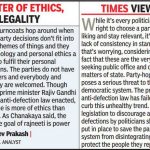
Will the turncoats spoil the chances of the ruling BJP returning to power in Karnataka’s May 10 Assembly polls?
The Party-hopping has peaked before the elections. How far these turncoats would damage the BJP is unknown. Despite its insisting that this migration would not affect its poll prospects, the exit of prominent faces could be bad optics.
The BJP already faces anti-incumbency and is battling allegations of corruption. Besides, the state has a tradition of not returning the ruling party to power. There are other issues like caste politics.
Some Veterans and old-timers are miffed over their non-inclusion in the candidate lists. The erosion is due to BJP’s calculated decision to purge older candidates for younger and new faces. Also, those who sense they would not get a ticket and those who could gauge the public’s mood against the party have defected to Congress and Janata Dal (Secular.)
Last week, the BJP fielded 52 new candidates and retained 90 sitting MLAs, including 11 from Congress and J.D. (S) who crossed over in 2019 to help it wrest power from the Kumaraswamy coalition.
The former chief minister, a former State BJP President, and a six-time MLA, Jagdish Shetter, tops the list of these migrants. BJP attempted damage control by offering him the post of governor or a central minister, but he rejected it to contest from a Congress ticket.
The other disappointed veterans include Laxman Savadi – a heavyweight Ex-deputy chief minister, S Angara- a six-time MLA, R. Shankar- BJP MLC and M P Kumaraswamy- Mudigere, BJP MLA. Most are from the influential Lingayat community, traditionally supporting the BJP since the late 1990s.
Defections are not new to Indian politics. The Congress Socialist Party broke away from Congress as early as 1948. The party split in Uttar Pradesh in 1950, Andhra Pradesh in 1953, and Haryana in 1967 (famous (Aya Ram Gaya Ram” case.) A Haryana legislator, Gaya Ram of the sixties, won first as an Independent, joined the Congress, and changed parties thrice again within a fortnight!
Karnataka has a long history of migrant and betrayal politics which resulted in government collapse not once or twice but several times. Between 1967 and 1983, there were approximately 2,700 defections at the state level, with 15 becoming chief ministers, according to PRS Legislative Research.
What is defection? A turncoat in politics happens when a legislator leaves the party on whose symbol they won and joins another party. These turncoats treat disqualification as a mere detour to return to the House by recontesting.
After the passage of the Anti-Defection Law in 1985 to check the menace, the pace fell, but the trend continued. A fourth of the current MLAs had won on a different party ticket and one in six won elections on more than one party ticket.
According to India Today’s Data Intelligence Team, of the 341 turncoat candidates in Karnataka in the last three assembly elections, 78 won, while 263 lost. Also, the count has increased over time, with the highest number in the 2018 election.
Incidentally, the BJP has been in power in Karnataka for nine years at different terms but has never secured a majority. It had to depend on the turncoats to form their government.
In the previous 2018 Assembly polls, the BJP won 104 out of the 224 seats. But J.D. (S) (37) and the Congress (76) coalition formed the government, though BJP emerged as the single largest party. However, the Kumaraswamy coalition government collapsed after the BJP engineered a coup with 18 MLAs from Congress and J.D. (S), bringing it back to power. Voters elected 15 of the 17 defected legislators in 2019.
The BJP leader Yediyurappa became the chief minister four times, the only leader to do so, but never once completed a full term. Two of his terms lasted just a few days each. His government collapsed in 2007, 2011, and 2018.
Why do the voters return the turncoats? The rival parties are willing to embrace them and field them again. They see the migration now as more of a vehicle that lends credibility and gets influential positions in their chosen party. Switching parties do not always affect the migrants. Of the 833 turncoats, BJP filed in the last decade, 44 percent of won re-elections.
Traditionally, turncoats depended on the migrant party’s goodwill, cadres, and ability to finance. Small-time leaders acquire a new image to win. In the case of famous leaders, they carry their vote bank.
The moral of the story is that turncoats can not be wished away by bringing stringent laws. They remain constant whichever party comes to power in a hung kind of Assembly.
Sadly, the turncoats are here to stay as long as political parties encourage them, the public votes for them to return, and defectors believe in self-interest. If the trend is not checked, it will damage Indian democracy. Awareness of the voters and shaming the turncoats could be the answer once the public sees the threat. (IPA Service)
The post Party Hopping Is A Normal Feature In Karnataka Before Or After Polls first appeared on IPA Newspack.


